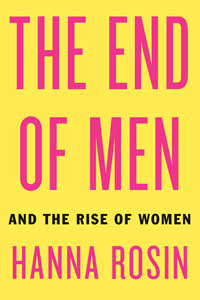Bring Your Questions for Hanna Rosin, Author of The End of Men

“In the Great Recession, three-quarters of the 7.5 million jobs lost were lost by men,” writes Hanna Rosin, author of the new book The End of Men (and the Rise of Women). “The worst-hit industries were overwhelmingly male, and deeply identified with macho: construction, manufacturing, high finance. Some of those jobs have come back, but the dislocation is neither random nor temporary. The recession merely revealed — and accelerated — a profound economic shift that has been going on for at least thirty years, and in some respects even longer.”
Rosin’s book (here are some reviews), based on her controversial 2010 Atlantic essay, explores the new American marriage divide, the education gap between young men and women around the world, and the new Asian power women. Here’s Rosin on the evolution of marriage among women without a college degree:
[T]he rise of women is associated with the slow erosion of marriage and even a growing cynicism about love. As the women in this second group slowly improve their lot, they raise the bar for what they want out of marriage — a Ryan Reynolds look-alike, a white Chevy. But the men of their class are failing to meet their standards. The men may cling to traditional ideals about themselves as providers, but they are further than ever from being able to embody these ideals. This is the class from which we draw our romantic notions of manhood, which inspired generations of country music and political speeches. But now the rising generation has come to think of lasting love as a fiction that lives on only in those speeches and pop songs.
By contrast, marriage among women with college degrees has evolved in a much different way:
Among the educated class, women’s new economic power has produced a renaissance of marriage. Couples in possession of college degrees are much more fluid about who plays what role, who earns more money, and, to some extent, who sings the lullabies. They have gone beyond equliaty and invented whole new models of marriage. I call these seesaw marriages, where the division of earnings might be forty-sixty or eighty-twenty — and a year or two later may flip, giving each partner a shot at satisfaction. More wives at the top are becoming the main breadwinners for some period of time, and, as a result of this new freedom, more couples are describing their marriages as “happy” or “very happy.” But even “happy” can hide complications.
Rosin has agreed to take questions from Freakonomics readers, so fire away in the comments section below. As always, we’ll post her answers in due course. Here’s the book’s table of contents to get you started:
Hearts of Steel: Single Girls Master The Hook Up
The Seesaw Marriage: True Love (Just for Elites)
The New American Matriarchy (The Middle Class Gets a Sex Change)
Pharm Girls (How Women Remade the Economy)
Degrees of Difference (The Education Gap)
A More Perfect Poison (The New Wave of Female Violence)
The Top (Nice-Ish Girls Get the Corner Office)
The Gold Misses (Asian Women Take Over the World)
This post is no longer accepting comments. The answers to the Q&A can be found here.

Comments